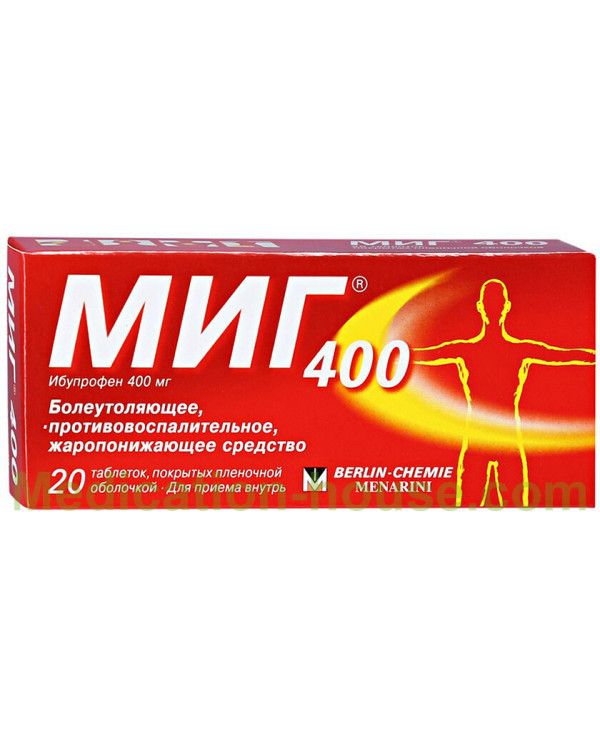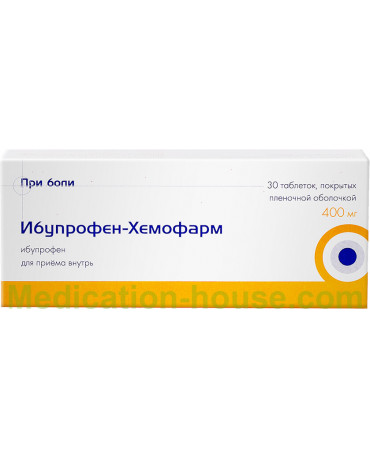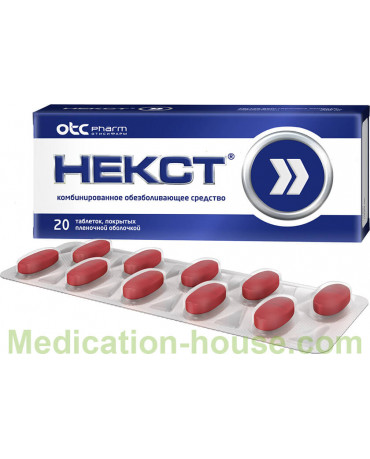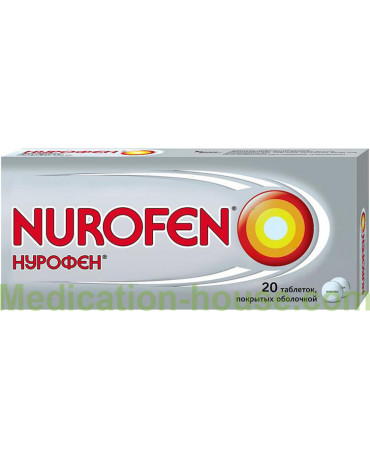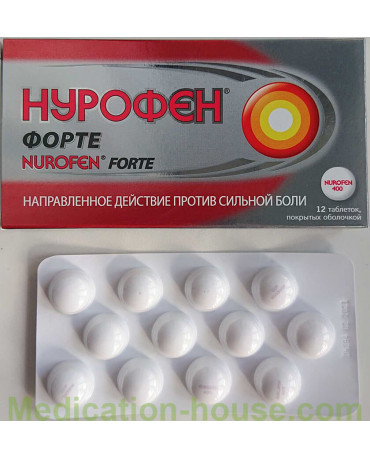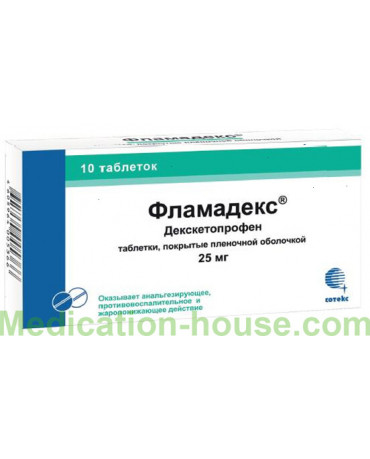Instruction for Mig 400
You can buy Mig 400 here
Composition
One tablet contains:
active ingredient - ibuprofen 400 mg
Excipients:
kernel composition: corn starch, anhydrous colloidal silicon dioxide, sodium starch glycolate (type A), magnesium stearate
shell composition: hypromellose (nominal viscosity 6 mPa · s),
macrogol 4000, povidone K 30, titanium dioxide (E 171)
Description
White or almost white, oblong tablets, film-coated, with a notch for division on both sides. On the upper side of the tablet on both sides of the notch is embossed "E".
Pharmacokinetics
Suction
When ingestion ibuprofen is partially absorbed already in the stomach, and then completely in the small intestine. When taken orally, the dosage form with the usual release peak concentration in plasma is achieved in 1 to 2 hours.
Distribution
Plasma protein binding is about 99%.
Biotransformation
Ibuprofen is metabolized in the liver (hydroxylation, carboxylation).
Excretion
Pharmacologically inactive metabolites are completely eliminated, mainly with urine (90%), as well as with bile. The half-life in healthy people and patients suffering from diseases of the liver and kidneys, is 1.8-3.5 hours.
Linearity / non-linearity
At doses of 200 to 400 mg, the linear kinetics of ibuprofen was observed. At higher doses, nonlinear kinetics of Mig 400 was observed.
Pharmacodynamics
Mechanism of action
Ibuprofen is a nonsteroidal anti-inflammatory drug that has an effective effect based on suppressing prostaglandin synthesis, as evidenced by the results of traditional animal studies. In humans, ibuprofen has antipyretic effects, reduces inflammatory pain and swelling. In addition, ibuprofen inhibits platelet aggregation caused by ADP and collagen.
Clinical efficacy and safety
Experimental data suggest that with simultaneous use with ibuprofen, the effect of inhibiting the effects of low doses of acetylsalicylic acid on platelet aggregation may be observed. During one study, when a single dose of ibuprofen 400 mg was taken 8 hours before or 30 minutes after taking a dose of instant aspirin (81 mg), there was a weakening of the effect of acetylsalicylic acid on thromboxane formation or on platelet aggregation. However, the insufficiency of these data and the uncertainty regarding the applicability of data obtained from ex vivo studies to clinical conditions suggest that with regard to regular ibuprofen intake, no definitive conclusions can be made, and with irregular intake, some clinically significant effects are considered unlikely.
Preclinical safety data
In animal tests, the subchronic and chronic toxicity of ibuprofen was manifested primarily in the form of lesions and ulcers of the gastrointestinal tract.
In in vitro and in vivo tests, clinically significant evidence of the presence of the mutagenic effect of ibuprofen was not obtained. In tests in rats and mice, evidence of the carcinogenic effect of ibuprofen was not found.
Ibuprofen caused the suppression of ovulation in rabbits and implantation disorders in various animals (rabbits, rats, mice). Experimental studies in rats and rabbits have shown that ibuprofen overcomes the placental barrier. After taking Mig 400 in the dose range that is toxic to the maternal organism, the offspring of rats showed an increased frequency of congenital defects (defects of the ventricular septum of the heart).
Indications for use
Symptomatic treatment
- pain syndrome of light and medium intensity
- febrile syndrome
Dosage and administration
The dosage depends on the details shown in the table below. The dosage of Mig 400 in children and adolescents depends on body weight and age. A single dose in children and adolescents is usually 7-10 mg / kg body weight with a maximum daily dose of 30 mg / kg.
The interval between doses depends on the symptoms and the maximum daily dose; it is not recommended to repeat the dose earlier than after 6 hours.
Only for short-term therapy!
If there are complaints that continue for more than 3 days in children and adolescents,
more than 3 days in the treatment of fever or 4 days in the treatment of pain in adults, you must consult a doctor.
Mode of application
MIG 400 should be taken without chewing and drinking plenty of liquid, during or after a meal.
Patients with sensitive stomach are advised to take MIG 400 while eating.
The manifestation of side effects can be minimized by using the smallest effective dose with the shortest duration of use needed to improve the condition.
Special patient groups
Elderly patients
Special dose adjustment is not required. In elderly patients, especially careful monitoring of the condition is necessary due to possible side effects.
Renal failure
For patients with impaired mild to moderate renal function, reducing the dose of Mig 400 is not required (for patients with severe renal insufficiency.
Liver failure
In case of abnormal liver function, mild and moderate dose reduction is not required (recommendations for patients with severe hepatic impairment.
Kids and teens
Instructions for use in children and adolescents.
If taking this drug by children older than 6 years of age and adolescents is needed for more than 3 days, or the symptoms are aggravated, consult a doctor.
Side effects of Mig 400
The following criteria are used to estimate the frequency of occurrence of side effects:
Very often: 1/10
Often: 1/100 to 1/10
Sometimes: 1/1 000 to 1/100
Rarely: 1/10 000 to 1/1 000
Very rare: 1/10 000
Frequency is not installed: it is impossible to estimate according to the available data.
The list of the following side effects includes those that occurred during the treatment with ibuprofen, including the side effects observed during long-term treatment with high doses in patients suffering from rheumatism. The established frequency, including very rare cases, refers to short-term treatment at daily doses of up to 1200 mg ibuprofen for an oral dosage form.
With regard to the following adverse drug effects, it is necessary to consider that they are mainly dose dependent, and vary between individuals.
The most frequent side effects were those of the gastrointestinal tract. The development of peptic ulcers, perforation or gastrointestinal bleeding is possible, sometimes with fatal outcome, especially in elderly patients. There is information about the occurrence of nausea, vomiting, diarrhea, flatulence, constipation, dyspepsia, abdominal pain, tarry stools, vomiting blood, ulcerative stomatitis, exacerbation of colitis and Crohn's disease after taking Mig 400. Gastritis is less common. The degree of risk of gastrointestinal bleeding depends on the dose of the drug and the duration of treatment.
During the treatment of NSAIDs, edema, high blood pressure and heart failure were also reported.
Clinical studies and epidemiological data suggest that with the use of ibuprofen, especially in high doses (2400 mg / day) and for a long time, the risk of arterial thrombosis (for example, myocardial infarction or stroke) may slightly increase.
Heart disorders
Very rarely: palpitations, heart failure, myocardial infarction.
Disruption of the blood and lymphatic system
Very rarely: blood disorders (anemia, leukopenia, thrombocytopenia, pancytopenia, agranulocytosis).
The first signs may be fever, sore throat, oral erosion, flu-like symptoms, severe weakness, nosebleeds and bleeding into the skin.
With long-term therapy, regular determination of the blood formula is necessary.
Nervous system disorders
Sometimes: disorders of the central nervous system, such as headache, dizziness, insomnia, agitation, irritability or fatigue.
Violations of the organs of sight
Sometimes: visual impairment.
Violations of the hearing and labyrinth
Rarely: tinnitus.
Disorders of the gastrointestinal tract
Often: complaints of the gastrointestinal tract, such as heartburn, abdominal pain, nausea, vomiting, flatulence, diarrhea, constipation and minor gastrointestinal bleeding, which in exceptional cases can cause anemia.
Sometimes: ulcers of the gastrointestinal tract with the likelihood of bleeding and perforation. Ulcerative stomatitis, exacerbation of colitis and Crohn's disease, gastritis.
Very rare: esophagitis, pancreatitis, formation of diaphragm-like intestinal strictures.
The patient should be instructed that when there is severe pain in the upper abdomen, with melena (tarry stool) and with bloody vomiting, stop taking Mig 400 and consult a doctor immediately.
Kidney and urinary tract disorders
Very rarely: the appearance of edema, especially in patients with arterial hypertension or renal failure; nephrotic syndrome, interstitial nephritis, which may be accompanied by acute renal failure.
In rare cases, renal tissue damage (renal papilla necrosis) can occur with an increase in the concentration of uric acid in the blood.
Therefore, it is recommended to regularly monitor the function of the kidneys.
Violations of the skin and subcutaneous adipose tissue
Very rarely: bullous reactions, including Stevens-Johnson syndrome and toxic epidermal necrolysis.
With chickenpox in exceptional cases, severe skin infections and soft tissue complications may develop (see also "Infections and Parasitic Diseases").
Infectious and parasitic diseases
Very rarely, cases of exacerbation of inflammatory processes of infectious origin (for example, the development of necrotizing fasciitis) associated with the use of non-steroidal anti-inflammatory drugs have been described. Perhaps this is due to the mechanism of action of NSAIDs.
When 400 signs of infection appear during MIG treatment or they increase, it is recommended to immediately consult a doctor. It is necessary to check if there are indications for anti-infective / anti-bacterial therapy.
Very rarely, when treating ibuprofen, symptoms of aseptic meningitis were observed, such as muscle stiffness in the neck, headache, nausea, vomiting, fever, or clouding of consciousness. Patients with autoimmune diseases (systemic lupus erythematosus, mixed collagenosis) are predisposed to the occurrence of such conditions.
Vascular Disorders
Very rarely: arterial hypertension.
Immune system disorders
Sometimes: hypersensitivity reactions, accompanied by skin rash and itching, as well as asthma attacks (in some cases with a drop in blood pressure).
Patients are advised in such cases to immediately stop taking the drug MIG 400 and consult a doctor.
Very rare: severe general hypersensitivity reactions. These reactions can manifest as edema of the face, tongue and larynx with narrowing of the respiratory tract, respiratory distress syndrome, heart palpitations, a drop in blood pressure, and even shock that is life-threatening.
If any of these symptoms occur, which can occur even with the first use of Mig 400, urgent medical assistance is needed.
Disorders of the liver and biliary tract
Very rarely: liver dysfunction, liver damage, especially with prolonged therapy, liver failure, acute hepatitis.
Mental disorders
Very rarely: psychotic reactions, depression.
Reports of possible adverse reactions
Reporting possible side effects after registering a drug plays an important role. This allows you to continue to monitor the “benefit / risk” ratio for this drug. Health workers are required to report possible side effects through the national alert system.
Contraindications
- in case of hypersensitivity to the active substance or any of the auxiliary substances
- in the presence of a history of reactions of bronchospasm, asthma, rhinitis or urticaria after taking acetylsalicylic acid or other nonsteroidal anti-inflammatory drugs
- in case of violations of blood formation of unknown origin
- if there is a recurrent peptic ulcer / bleeding in the present or in the past (two or more separate episodes of confirmed peptic ulcer or bleeding)
- in the presence of a history of gastrointestinal bleeding or perforation of the ulcer associated with the previously prescribed therapy with nonsteroidal anti-inflammatory drugs;
- at cerebrovascular bleeding or other bleeding currently available
- for severe violations of the kidneys or liver
- with severe heart failure
- the third trimester of pregnancy
- children weighing less than 20 kg (6 years), since the available dosage (content) of the active substance is not suitable for them
Drug interactions
Ibuprofen (like other NSAIDs) requires special care when taken with the following drugs:
Other NSAIDs, including salicylates:
The simultaneous administration of several NSAIDs may increase the risk of ulcers of the gastrointestinal tract and bleeding due to the synergistic effect. In this regard, the simultaneous use of ibuprofen and other NSAIDs is not recommended.
Digoxin, Phenytoin, Lithium:
The use of Mig 400 simultaneously with digoxin, phenytoin or lithium may increase the concentration of these drugs in plasma. Control of the concentration of lithium, digoxin and phenytoin in plasma when properly used, as a rule, is not required (maximum 4 days).
Diuretics, ACE inhibitors, beta-blockers and angiotensin II antagonists:
NSAIDs may decrease the effectiveness of diuretics and other antihypertensive drugs. In some patients with impaired renal function (for example, in patients with dehydration, or in patients in advanced age with impaired renal function), co-administration of ACE inhibitors, beta-blockers or angiotensin II antagonists, as well as substances that suppress cyclooxygenase, can cause a further reduction in renal function (up to acute renal failure), which is usually reversible. Therefore, the joint intake of these drugs should be prescribed with caution, especially in elderly patients. Patients should receive enough liquid. Both after initiation of joint therapy and subsequently, renal function should be periodically monitored closely.
At the same time taking the drug Mig 400 and potassium-sparing diuretics may develop hyperkalemia.
Corticosteroids:
Increased risk of developing gastrointestinal ulcers or bleeding.
Platelet aggregation inhibitors and selective serotonin reuptake inhibitors (SSRIs):
Increased risk of gastrointestinal bleeding.
Acetylsalicylic acid in small doses:
Experimental data suggest that with simultaneous use with ibuprofen, the effect of inhibiting the effects of low doses of acetylsalicylic acid on platelet aggregation may be observed. However, the limitations of these data, as well as the uncertainty regarding the transfer of ex vivo data to the clinical situation, do not allow definite conclusions about the regular use of ibuprofen, and if it is not used regularly, clinically significant reactions are unlikely
Methotrexate:
Taking Mig 400 within 24 hours before or after taking methotrexate can lead to an increase in the concentration of methotrexate and an increase in its toxic effect.
Cyclosporine:
Simultaneous use of certain nonsteroidal anti-inflammatory drugs increases the risk of kidney damage due to the action of cyclosporine. The appearance of this effect is not excluded with the combination of cyclosporine with ibuprofen.
Anticoagulants:
NSAIDs can enhance the action of anticoagulants such as warfarin.
Sulfonylurea preparations:
The results of clinical studies indicate the presence of the interaction of nonsteroidal anti-inflammatory drugs with antidiabetic drugs (sulfonylurea drugs). Despite the fact that the interaction of ibuprofen with sulfonylurea drugs has not yet been described, while taking these medicines, for prophylactic purposes, it is recommended to control blood sugar levels.
Tacrolimus:
Simultaneous administration increases the risk of nephrotoxic effect.
Zidovudine:
There is evidence that with simultaneous use of zidovudine and ibuprofen in HIV-infected patients with hemophilia, the risk of hemarthrosis and hematomas increases.
Probenecid and sulfinpirazon:
Drugs containing probenecid and sulfinpyrazone can delay the elimination of ibuprofen from the body.
special instructions
Gastrointestinal Precautions
The use of Mig 400 in conjunction with non-steroidal anti-inflammatory drugs (NSAIDs), including selective cyclooxygenase-2 inhibitors, should be avoided.
The manifestation of side effects can be minimized by using the smallest effective dose with the shortest duration of use needed to improve the condition.
Elderly patients:
Elderly patients have an increased incidence of adverse reactions to nonsteroidal anti-inflammatory drugs, especially such as gastrointestinal bleeding and ulcer perforation, which can be life-threatening.
Gastrointestinal bleeding, ulceration and ulcer perforation:
In connection with the intake of NSAIDs, gastrointestinal bleeding, ulcers or perforations of ulcers that could pose a threat to the patient’s life were reported during the entire treatment period, both with and without the appearance of precursor symptoms, and side of the gastrointestinal tract in history.
The risk of gastrointestinal bleeding, the formation of an ulcer or its perforation increases with an increase in the dose of NSAIDs in patients with a peptic ulcer disease in history, especially complicated by bleeding or perforation, as well as in elderly patients. Treatment of these patients should be started with the lowest possible dose. For these patients, as well as patients who require concomitant therapy with low doses of aspirin or other drugs that increase the risk of gastrointestinal disturbances, consider using combination therapy with remedies (eg, misoprostol or proton inhibitors). pumps).
Patients with a history of toxic effects on the gastrointestinal tract, especially the elderly, should report any unusual sensations in the abdomen (especially gastrointestinal bleeding), especially in the initial stages of treatment.
At the same time taking with drugs that can increase the risk of ulcers or bleeding should be especially careful. Such drugs include oral corticosteroids, anticoagulants, such as warfarin, selective serotonin reuptake inhibitors, or antiplatelet agents, such as aspirin.
If an ulcer is formed or gastrointestinal bleeding develops during the use of MIG 400, therapy should be canceled.
Non-steroidal anti-inflammatory drugs should be used with caution in patients with diseases of the gastrointestinal tract in history (ulcerative colitis, Crohn's disease), because they can exacerbate these diseases.
Effects on the cardiovascular system and brain vessels
Mig 400 should be prescribed with caution to patients with arterial hypertension and / or heart failure in history (consultation of a physician or pharmacy worker is required), since the treatment of NSAIDs has resulted in fluid retention in the tissues, arterial hypertension and the development of edema.
According to the results of clinical studies and epidemiological data, the use of ibuprofen, especially in high doses (2400 mg daily) and for a long time, may be accompanied by some increase in the risk of arterial thrombosis (for example, myocardial infarction or stroke). In general, epidemiological studies show that small doses of ibuprofen (for example, 1200 mg / day) do not lead to an increase in the risk of myocardial infarction.
Skin reactions
There are reports that in very rare cases, the development of severe skin reactions, sometimes leading to death, including such as exfoliative dermatitis, Stevens-Johnson syndrome and toxic epidermal necrolysis has been associated with the use of NSAIDs. Apparently, patients are most at risk at the beginning of treatment, since in most patients, these reactions developed in the first month of therapy. At the first appearance of a skin rash, damage to the mucous membranes or any other signs of hypersensitivity, the use of Mig 400 should be discontinued.
Other instructions
Mig 400 can be used only after a thorough evaluation of the benefit / risk ratio in the following cases:
- With systemic lupus erythematosus (SLE) and mixed collagen diseases - the risk of aseptic meningitis increases.
Particularly careful medical observation is required:
- for disorders of the gastrointestinal tract or in the presence of a history of chronic inflammatory bowel disease (ulcerative colitis, Crohn's disease);
- With high blood pressure or heart failure;
- in case of impaired renal function
- at dysfunction of a liver
- directly after extensive surgical interventions
- with allergies to pollen, nasal polyps and chronic obstructive respiratory diseases, since these patients have an increased risk of allergic reactions. These reactions may manifest as attacks of asthma (so-called analgesic asthma), angioedema, or urticaria
- in case of allergy to other drugs, since such patients have an increased risk of hypersensitivity reactions, including when treated with Mig 400.
Severe acute hypersensitivity reactions (for example, anaphylactic shock) are extremely rare. At the first signs of hypersensitivity reactions after taking Mig 400, treatment should be stopped immediately. Necessary medical measures in accordance with the symptoms should be taken by qualified professionals.
Ibuprofen, the active ingredient of Mig 400, can temporarily inhibit platelet function (platelet aggregation). In this regard, it is necessary to establish a thorough medical observation of patients with bleeding disorders.
With long-term use of the drug Mig 400 requires regular monitoring of indicators of liver function, kidney function, as well as complete blood count.
Prolonged use of any painkillers used to treat headache can lead to its intensification. In the presence of this situation or suspicion of it, it is necessary to stop therapy and seek medical help. Suspected diagnosis of headache caused by excessive use of drugs, occurs in patients who often or daily have headaches, despite the regular use of drugs for headache or as a consequence.
In general, frequent, “habitual” use of painkillers, in particular the use of a combination of several painkillers, can lead to the development of irreversible kidney damage, accompanied by the risk of renal failure (“analgesic” nephropathy).
In special cases, against the background of varicella, severe infectious complications of the skin and soft tissues can develop. To completely eliminate the possibility of the relationship of NSAIDs with the development of such infectious complications today is impossible. Therefore, it is recommended to avoid taking Mig 400 with chickenpox.
When alcohol is consumed during the period of NSAID treatment, there may be an increase in the risk of side effects, in particular, from the gastrointestinal tract or the central nervous system.
Regarding family fertility, see the pregnancy and lactation section.
Children and teenagers:
With dehydration in children and adolescents there is a risk of kidney damage.
Pregnancy
Suppression of prostaglandin synthesis may adversely affect pregnancy and / or the development of the embryo and fetus. According to the results of epidemiological studies, it can be assumed that drugs that suppress prostaglandin synthesis used in the early stages of pregnancy can increase the risk of spontaneous abortion, as well as the occurrence of heart disease and gastroschisis. It is believed that the risk increases with increasing dose of Mig 400 and the duration of therapy.
In animals, the administration of a prostaglandin synthesis inhibitor has contributed to an increase in pre- and postimplantation losses and embryo-fetal mortality. In addition, in animals that received inhibitors of prostaglandin synthesis during organogenesis, the incidence of various malformations, including the cardiovascular system, increased.
During the first and second trimester of pregnancy, the appointment of ibuprofen is possible only for health reasons. In the case of the appointment of ibuprofen, women who are planning a pregnancy, or in the first and second trimester of pregnancy should choose the lowest possible dose and the shortest possible duration of treatment.
In the third trimester of pregnancy, all prostaglandin synthesis inhibitors:
- can lead to the fetus:
cardiopulmonary toxicity (with premature closure of the ductus arteriosus and pulmonary hypertension);
renal dysfunction, which can progress to renal failure with the development of oligohydramnios;
- the following deviations are possible for the mother at the end of pregnancy and for the newborn:
a possible increase in bleeding time - the effect of inhibiting platelet aggregation, which can occur even with the use of Mig 400 in very low doses;
suppression of uterine contractile activity, leading to a delay or delay in labor activity.
In this regard, in the third trimester of pregnancy, ibuprofen is contraindicated.
Lactation
The active ingredient ibuprofen and its breakdown products in small quantities into breast milk. Since no information on adverse effects on newborns has been reported so far, with short-term therapy, interruption of breastfeeding is usually not required.
Fertility
There is evidence that drugs that inhibit cyclooxygenase / prostaglandin synthesis can have a negative effect on the reproductive ability of women through effects on ovulation. Such effects are reversible after cessation of treatment.
Influence on ability to drive a vehicle or potentially dangerous machinery
When taking the drug MIG 400 in high doses, such undesirable effects on the part of the central nervous system as increased fatigue and dizziness are possible, therefore, in some cases, the reaction may be disturbed, the ability to drive and work with mechanisms. These phenomena are enhanced by the combination of Mig 400 with alcohol.
Overdose
Symptoms
Overdose symptoms can be disorders of the central nervous system, in particular headache, dizziness, lethargy and loss of consciousness (myoclonic convulsions in children), as well as abdominal pain, nausea and vomiting. In addition, gastrointestinal bleeding and impaired liver and kidney function are possible. Possible reduction in blood pressure, respiratory depression and cyanosis.
Treatment
There is no specific antidote.
Therapeutic options for the treatment of intoxication are determined by the degree, level and clinical symptoms in accordance with the general provisions of intensive therapy.
Release form and packaging
On 10 tablets place in a blister strip packaging from a white rigid film of a polyvinyl chloride and soft foil with aluminum, laminated paper.
For 1 or 2 blister packs together with instructions for medical use in the state and Russian languages, they put in a cardboard pack.
Storage conditions
Store at a temperature not exceeding 25ºC.
Keep out of the reach of children!
Shelf life - 3 years.
Do not use after the expiration date.
Terms of sell
You don't need a prescription to buy Mig 400.

